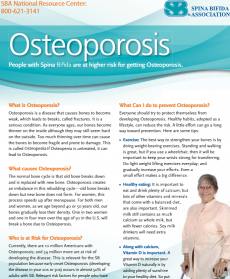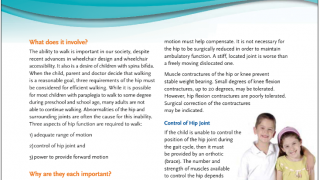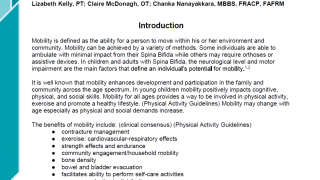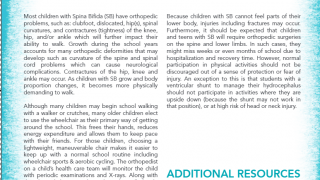People with Spina Bifida are at higher risk for getting osteoporosis.
What is Osteoporosis?
Osteoporosis is a disease that causes bones to become weak, which leads to breaks, called fractures. It is a serious condition. As everyone ages, our bones become thinner on the inside although they may still seem hard on the outside. Too much thinning over time can cause the bones to become fragile and prone to damage. This is called osteopenia. If osteopenia is untreated, it can lead to osteoporosis.
What causes Osteoporosis?
The normal bone cycle is that old bone breaks down and is replaced with new bone. Osteoporosis creates an imbalance in this rebuilding cycle—old bone breaks down, but new bone does not form. For women, this process speeds up after menopause. For both men and women, as we age beyond 40 or 50 years old, our bones gradually lose their density. One in two women and one in four men over the age of 50 in the U.S. will break a bone due to osteoporosis.
Who is at risk for Osteoporosis?
Currently, there are 10 million Americans with Osteoporosis; and 34 million more are at risk of developing the disease. This is relevant for the SB population because early onset Osteoporosis (developing the disease in your 20s or 30s) occurs in almost 50% of adults with SB. Relevant risk factors for people who have SB include: being female, immobility or reduced physical activity, renal failure, prior ileal diversion surgery, use of epilepsy medications or corticosteroids, family history of hip fractures or diagnosis of Osteoporosis.
What can I do to prevent Osteoporosis?
Everyone should try to protect themselves from developing Osteoporosis. Healthy habits, adopted as a lifestyle, can reduce the risk. A little effort can go a long way toward prevention. Here are some tips:
Exercise
The best way to strengthen your bones is by doing weight-bearing exercises. Standing and walking is great, but if you use a wheelchair, then it will be important to keep your wrists strong for transferring. Do light weight lifting exercises every day; and gradually increase your efforts. Even a small effort makes a big difference.
Healthy eating
It is important to eat and drink plenty of calcium; but lots of other vitamins and minerals that come with a balanced diet, are also important. Skim milk still contains as much calcium as whole milk, but with fewer calories. Soy milk drinkers will need extra
vitamins.
Along with calcium, Vitamin D is important.
A great way to increase your Vitamin D naturally is by adding plenty of sunshine to your healthy diet. So put on plenty of sunscreen
and soak up the rays when you can. For many people, diet and sunshine are not enough, and a doctor might recommend Vitamin D or Calcium supplements.
Monitor caffeine and alcohol intake
Avoid drinking too much caffeine because it can affect the balance of calcium in your body. Minimize alcohol consumption
because drinking too much alcohol is also damaging to the bones.
Avoid smoking
Smoking causes damage to bone and the rest of the body. If you smoke and can’t quit on your own, then ask your doctor or pharmacist for help.
Is there a test for Osteoporosis?
Screening for bone loss is important because Osteoporosis usually shows no symptoms until the time of the broken bone. In middle-aged people, wrists, hips, and spinal bones are the most common areas of fracture. In younger people, however, common sites of fractures are the lumbar spine and hip. These fractures can be very painful and dangerous. Dual-emission X-ray absorptiometry (DXA, previously DEXA) is a means of measuring bone mineral density (BMD). Two X-ray beams with differing energy levels are aimed at the patient’s bones.
The problem with DXA is that it is typically done in the lower back, the hip, or the heel, common places that are already abnormal in Spina Bida, which makes it hard to do the test. Thus, some places are testing at the wrist or in the long bone of the leg (femur). People with Spina Bifida should talk to their doctor to determine whether this test is appropriate and if so, discuss what part of the
body should be used for testing. In general, high bone mineral density means stronger bones. Stronger bones equal less risk for osteoporosis and fractures.
How can Osteoporosis be treated?
There are medications that effectively preserve or maintain bone density, especially during menopause —and decrease the risk of breaking a bone as a result of osteoporosis. They are most effective when taken before osteopenia becomes osteoporosis, however. For that reason, early discussion with your doctor is important.
This information does not constitute medical advice for any individual. As specific cases may vary from the general information presented here, SBA advises readers to consult a qualified medical or other professionals on an individual basis.
Tags



